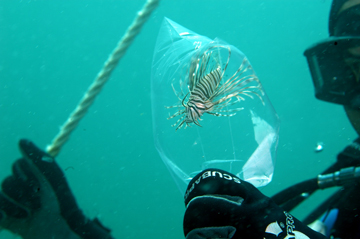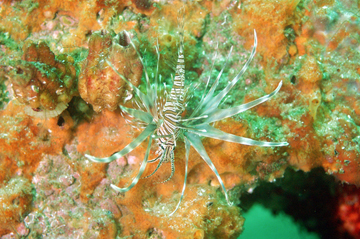
Population spreading, NOAA, FWC seek information
From the Desk of the FWC –
By Stan Kirkland, FWC
It sounds like something out of a B-rated horror movie but a non-native predatory fish called the lionfish has become established in marine waters of the southeastern United States and Caribbean, and may spell trouble for many marine fish.
The first report of a lionfish was near Dania Beach off southeast Florida in 1985. Lionfish populations have increased since then and the species has been spotted as far north as the waters off Rhode Island in the Atlantic and in the warmer Gulf waters off Louisiana.
Martha Bademan, an environmental specialist with the Florida Fish and Wildlife Conservation Commission’s (FWC) Division of Marine Fisheries Management said it’s believed lionfish were originally introduced in marine waters from someone’s aquarium.
Since then, lionfish have become established on the East Coast and have expanded throughout the Caribbean. Scientists believe that lionfish juveniles from Caribbean lionfish populations are carried by ocean currents to Florida waters.
The colorful predatory fish, which is native to Indo-Pacific waters, gets 12-15 inches long and has a high reproductive potential. The females can spawn several times per month and release up to 30,000 eggs every four days per spawn.

As lionfish grow they switch their diet from invertebrates to fish, and therein lies the concern, according to Bademan.
“They are eating native fish and competing with native predatory fish such as grouper and snapper,” she said. “They are also likely to have a negative impact on overall reef habitat, since they feed on herbivorous fish that keep the algae in check on the reefs.”
Bademan said one of the best things divers and anglers can do is to collect and remove the fish. Under Florida law, a person with a recreational fishing license can collect up to 100 pounds of lionfish per day.
Lionfish have become so numerous in the Florida Keys, tournaments were held in 2010 and 2011. In 2010, divers removed 654 lionfish over the three-day event. In the latter, they removed 531 in a single day.
Lionfish have venom glands in their dorsal, pelvic and anal spines. They should never be handled with a bare hand. Divers usually use either handheld nets or spears to capture the fish.
Bademan says anyone who sees a lionfish is urged to call 877-786-7267, the reporting number sponsored by the U.S. Geological Survey and U.S. Fish and Wildlife Service. Online reports can be made at http://nas.er.usgs.gov/sightingreport.asp.
Additionally, NOAA is interested in lionfish sightings and collecting specimens in the Gulf of Mexico. Information is available online at MyFWC.com/reportlionfish.
Lionfish have been observed as far west as Louisiana in the Gulf. Also, lionfish have been observed as far north as Rhode Island, not New York. If you are interested, here is the USGS map that shows where lionfish have been reported in the Western Atlantic: http://nas2.er.usgs.gov/viewer/omap.aspx?SpeciesID=963.
